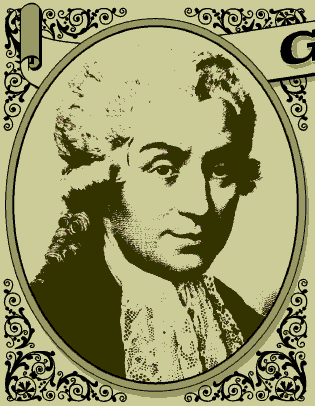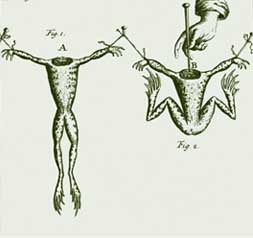Luigi Galvani
 Galvani Galvani
In a very careful series of
experiments in which he fastened “brass
hooks in their [the frogs'] spinal cord to an
iron railing which surround a certain hanging
garden of my house” Galvani noticed that the
frogs' legs went into contractions “not only
when the lightning flashed but even at times when
the sky was quiet and serene.” In the
contact between the brass hooks and the iron
railing, Galvani came tantalizingly close to the
contact theory later advanced by his
fellow-countryman, Allesandro Volta. However,
Galvani chose to interpret his results in terms
of “animal electricity,” which
proclaimed that the structure of the muscle
retained a “nerveo-electrical fluid”
similar to that of an electric eel.
http://www.bioanalytical.com/calendar/97/galvani.htm
Luigi Galvani
Layton-Ramirez
Inc.
Science itself is always a surprise,
uncovering new and sometimes unexpected
things. Even a planned search for
information may lead to an expected chance,
observation, or discovery. Galvani
apparently by accident, noticed the convulsions
of frogs' legs in certain circumstances. He
pursued his discovery of "animal
electricity" faithfully and unknowingly
observed the physiological result of the electric
current. The modern study of
neurophysiology has its beginning by the chance
observations made by the Italian anatomist, Luigi
Galvani.
http://www.geocities.com/BourbonStreet/Quarter/4801/index.htm
Galvani
"Therefore having noticed that
frog prparations which hung by copper hooks from
the iron railings surrounding a balcony of our
house contracted not only during thunder storms
but also in fine weather, I decided to determine
whether or not these contractions were due to the
action of atmospheric electricity....Finally....I
began to scrape and press the hook fastened to
the back bone against the iron railing to see
whether by such a procedure contractions might be
excited, and whether instead of an alteration in
the condition of the atmospheric electricity some
other changes might be effective. I then noticed
frequent contractions, none of which depended on
the variations of the weather."
http://www.chem.uidaho.edu/~honors/galvani.html
 Luigi Galvani Luigi Galvani
Though Luigi Galvani erroneously
concluded that the frog's nervous system
generated an electical charge, his work
stimulated much research into the electrical
nature of the nervous impulse.
http://www.cmp.ucr.edu/site/exhibitions/frogs/pages/galv.htm
Catholic Encyclopedia: LUIGI GALVANI
Physician, b. at Bologna, Italy, 9
September, 1737; d. there, 4 December, 1798. It
was his original intention to study theology and
to enter a monastic order. His family, however,
persuaded him to abandon that idea. He took up
the study of the natural sciences from the point
of view of the anatomist and physiologist.
Galvani's work in comparative anatomy and
physiology includes a study of the kidneys of
birds and of their sense of hearing. He is famous
more especially on account of his experiments
concerning "the electrical forces in
muscular movements", leading up to his
theory of animal electricity. This began with the
accidental observation, in 1780, of the twitching
of the legs of a dissected frog when the bared
crural nerve was touched with the steel scalpel,
while sparks were passing from an electric
machine nearby.
http://www.newadvent.org/cathen/06371c.htm
Galvani's Laboratory, c. 1791
Visible in this engraving is the
electrical apparatus Luigi Galvani used to
produce an electric cell with the fluids
extracted from the body of a frog.
http://www.english.upenn.edu/~jlynch/FrankDemo/Gifs/galvlab.html
|



